Dermclinic: A 4-Case Quiz on Fingernails
Case 1: During the past few weeks, a 14-year-old boy has noticed blood on the proximal nail folds of the second and third fingers of his dominant hand. He denies any pain or pruritus. The patient is otherwise healthy and takes no prescription medications.Which of these questions do you ask the patient?A. What sports do you play?B. What are your extracurricular activities?C. Do you bite your nails?D. Do you take any over-the-counter medications or alternative remedies?E. All of the above. (Answer on next page.)
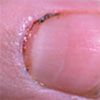
Case 1:
During the past few weeks, a 14-year-old boy has noticed blood on the proximal nail folds of the second and third fingers of his dominant hand. He denies any pain or pruritus. The patient is otherwise healthy and takes no prescription medications.
Which of these questions do you ask the patient?A. What sports do you play?
B. What are your extracurricular activities?
C. Do you bite your nails?
D. Do you take any over-the-counter medications or alternative remedies?
E. All of the above.
(Answer on next page.)

Case 1: Trauma
On further questioning, E, the patient revealed that this condition occurred after he began playing a bass guitar. The patient was advised to use a pick-not his fingers-when strumming. The trauma-induced bloody nail folds cleared, and the problem has not recurred.
Bacterial and fungal infections typically are more painful and are associated with inflammation, which was absent here. No features of psoriasis, such as pitting and/or nail-bed discoloration that resembles an oil slick, were noted. The patient denied any other exacerbating factors.
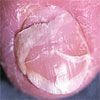
Case 2:
A 55-year-old woman seeks treatment of a deformed, slightly tender nail plate and swollen, erythematous nail folds; she first noticed the condition several months earlier. The only medication she takes is thyroid hormone.
What is your initial approach?A. Measure the patient's thyroxine level.
B. Measure the patient's thyroid-stimulating hormone level.
C. Order a bacterial culture.
D. Order a fungal culture.
E. Order a radiograph of the finger.
(Answer on next page.)

Case 2: Chronic paronychia
Chronic paronychia is caused most commonly by a species of Candida; a fungal culture, D, confirmed the presence of Candida albicans. Once the infection is treated, the nail plate deformity grows out; this process can take up to 6 months. The nail pitting seen in this patient is not relevant to this condition.
Hyperthyroidism can present with distal onycholysis; however, it does not produce the nail plate deformity and inflammation seen here. Bacterial infections are more acute and more painful.
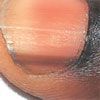
Case 3:
During a routine examination, these dark streaks are noted on the fingernails of a 28-year-old woman. She denies any trauma. There is no history of melanoma or atypical moles.
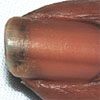
How would you proceed?A. Perform a biopsy.
B. Offer reassurance.
C. Search the entire body for pigmented lesions.
D. Schedule a follow-up examination in 3 to 6 months.
E. Perform a fungal culture.
(Answer on next page.)

Case 3: Melanonychia
Melanonychia, or pigmented nail streaks, are common in persons with dark skin. When more than 1 nail is involved, as in this patient, reassurance, B, is the only treatment necessary.

A single streaked nail in a fair-skinned person may indicate dysplastic nevus or melanoma. A biopsy, therefore, is warranted in this setting.
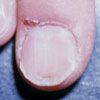
Case 4:
For several months, a 32-year-old man has had ridged, concave fingernails. He is otherwise healthy and takes no medications. The patient restores old houses for a living.
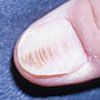
Which condition in the differential is the most likely diagnosis?A. Koilonychia.
B. Onycholysis.
C. Onychorrhexis.
D. Onychoschizia.
E. Onychomycosis.
(Answer on next page.)

Case 4: Koilonychia
This is trauma-induced koilonychia, A, or spoon nails. The transverse grooves, or Beau lines, are caused by injury to the growing part of the nail plate, which in this patient was incurred on the job. Koilonychia can be associated with anemia; a complete blood cell count or iron level measurement may be prudent.

Onycholysis is often associated with hyperthyroidism. Onychorrhexis is longitudinal nail ridging that naturally occurs with aging. Onychoschizia is lamellar splitting of the distal nail plate. The absence of a thickened nail plate and subungual debris ruled out onychomycosis in this patient.